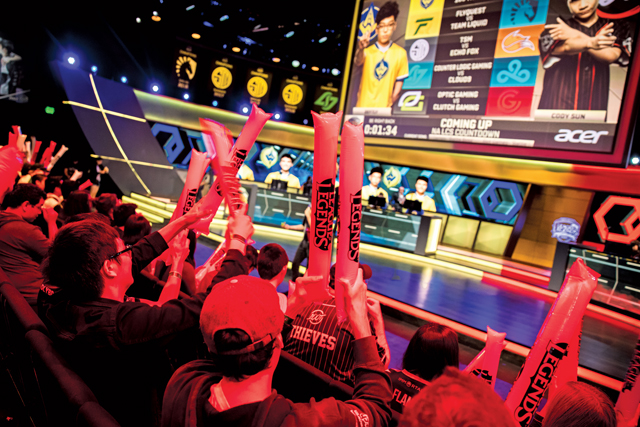The Los Angeles video game industry is going live.
In the last two years, home-grown Activision Blizzard Inc., Riot Games Inc. and NantG Mobile have established arenas for broadcasting live gaming competitions, known as e-sports.
South Korea-based OGN and Pearl Abyss Corp. have also set up local e-sports venues while USC and UCLA are considering building scaled-down e-sports competition spaces for their newly established teams. And Santa Monica-based Super League Gaming Inc., an online platform that connects gamers and aids tournament organization, went public on Nasdaq earlier this year.
“There’s been a trend that’s gone from development of games to the gameplay space (and then) to live competitions, and that’s all happening in L.A.,” said Brian Mirakian, senior principal at Kansas City, Mo.-based sporting and e-sports venue design firm Populous Inc.
The arenas add a new revenue stream for the video game studios as the popularity of watching expert gamers compete is growing worldwide.
In 2018, e-sports globally generated more than $54.7 million in ticket revenues from roughly 737 e-sports events, according to industry tracker Newzoo. The group estimated $96 million was spent on tickets and merchandise at e-sports events during 2018, up 16 percent from the prior year.
But the L.A. market offers some particular advantages for live video game businesses, aside from being close to home for some big-name studios.
For one, it’s an ideal testing ground, said Chris Rico, director of innovation for the Los Angeles County Economic Development Corp. “Because of (L.A.’s) ethnic diversity, we are this cultural nexus where if you want to experiment, there’s no better marketplace than here,” Rico said.
Mirakian added that location is also a key factor since many top players travel to the live events from Asia and other parts of the world, he said. “Ease of flights to (Los Angeles International Airport) and out is good, a lot of critical infrastructure is already in place, which is why L.A. is naturally becoming a first choice,” for e-sports arena development, Mirakian said.
“The Staples Center of e-sports”
Live video game competitions have been around since the 1980s when Atari Interactive Inc. hosted one of the first events. In the late 1990s, online e-sports gained popularity in internet cafes, with some of the earliest competitions starting in South Korea. The country established the Korean E-sports Association in 2000 to regulate and promote competitions.
Since then, the worldwide industry has exploded.
Santa Monica-based Activision Blizzard entered the sector in 2015 with the creation of its e-sports division and the “Call of Duty” World League, where top players compete for multimillion-dollar prize pools.
The company in 2017 opened arenas in Taipei and Burbank. The Burbank venue, known as the Blizzard Arena, holds roughly 450 spectators and hosts 20 events per year. On its website, Blizzard describes the arena as “more than just a place for the most epic contests in the world of esports; it is a crucible where champions become legends.”
Riot Games, located in Sawtelle, operates two e-sports venues. In 2016, the company built out a small arena on its headquarters’ campus to host a championship for its popular online role-playing game “League of Legends.”
Riot also opened a 59,000-square-foot arena in Seoul, South Korea, in 2017 to broadcast the “League of Legends” Champions Korea tournament.
In El Segundo, biotech mogul Patrick Soon-Shiong’s new mobile gaming venture NantG Mobile is turning a 100,000-square-foot former party rental building into a multipurpose e-sports arena.
Soon-Shiong told the Business Journal in September that “the idea is to create the Staples Center of e-sports.”
Manhattan Beach saw the entry of two South Korean gaming companies last year, including Korean telecommunications outfit OGN, which signed a 10-year lease for a 35,000-square-foot arena that opened in December. OGN partnered with game developer PUBG Corp., which distributes “PlayerUnknown’s Battlegrounds,” a multiplayer video game.
“Creating an immersive experience for the fans is paramount,” said D.J. Lee, chief executive of CJ E&M America Inc., the U.S. division of CJ E&M Co. Ltd.
Pearl Abyss Corp., another South Korean game publisher, moved into Manhattan Beach in December. The company’s 35,000-square-foot arena is near Pearl Abyss’ headquarters at the Onni Group of Cos. Ltd. towers.
Collegiate e-sports
The region’s universities are creating e-sports arenas for college play as well. UCLA has eight competitive e-sports teams, four junior varsity and four varsity, with about 64 players participating. The program was established in 2017 and is affiliated with UCLA Club Sports and Recreation.
UCLA Recreation Coordinator Ian Collis said the university is considering building an e-sports arena, “but that’s well in the future.” Collis said other renovations to the school’s sports facilities will take priority over e-sports.
Nationwide, collegiate e-sports began around 2010 and has grown from one team to nearly 125, governed by the National Association of Collegiate Esports.
A more recent entrant, USC established an e-sports program with 16 players in November. The team’s inaugural competitive season starts this month, said Dan Bilson, director of USC Games. Bilson said the college works closely with Riot Games and began collaborating with Activision Blizzard a month ago, with plans to add their games to its competitions.
“Our first thing is to promote and celebrate the culture of video games,” Bilson said. Many teams rent out retail space and run internet cafes that help fund their operations, Bilson added.
For now, a USC-owned firehouse on campus will host team practices. Bilson said the university has considered building a competitive arena, but no concrete plans are in place for that yet.

